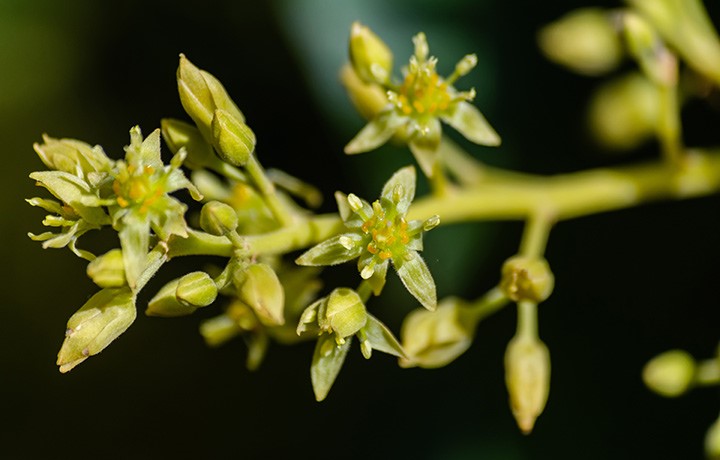Avocado flowering: key aspects of management

Avocado flowering requires precise management to obtain optimal crop yields. The avocado flower is as delicate as it is beautiful, in fact it estimated that less than 1% of avocado flowers reach fruit set phase. That is, for every thousand flowers produced, only 1 to 3 fruits are harvested. The rest of the flowers drop off the plant without producing fruit.
In such an important process in the crop's phenology, it is recommended to use biostimulants for avocados that act on the 4 key points in the flowering process: development of the flower, pollination, fertilisation and fruit set. Kynetic4 is a solution of botanical origin developed by Seipasa to act specifically on these 4 points.
Various climate factors affect flowering in avocados. The first of these is temperature. Both harsh frosts and intense heat affect photosynthetic activity in the plant, and it suffers when temperatures drop below 15 degrees or rise above 40 degrees.
The variant of temperature is crucial in the current context and recent studies warn of the impact of climate change on the Hass variety, which is the most widespread in the world. Global warming is causing plants to flower up to 3 weeks earlier and exposing them to the risk of cold weather or rain at the end of winter.
The avocado flower is also susceptible to drought stress and to lack of sunlight, although the latter can be resolved by thinning operations.
Along with temperature, drought stress or luminosity, the most important factor for flowering in avocado plants is without doubt the production of carbohydrates. The plant's metabolism requires energy in the form of carbohydrates to develop key processes such as fertilisation of flowers, fruit set and fruit growth.
Production of carbohydrates is intrinsically linked to plant nutrition, an aspect in which there is ample room for manoeuvre in agriculture to improve performance and increase productivity in avocado growing.
It is here that the application of biostimulant solutions comes into play as they provide numerous benefits and improve flowering quality and fruit set in avocado plants. Kynetic4 is Seipasa's biostimulant that is specifically designed to act on the 4 key points in the flowering process.
This solution of botanical origin is based on the combination of high-value precursor amino acids that encourage the synthesis of specific proteins and make them available to the plant at times of greatest energy demands. This energy input is decisive since flowering in avocados is one of the critical moments of the plant's energy needs and demands. The different organs of the avocado require carbohydrates to develop and so they compete for them.
Kynetic4 provides flowering stimulation molecules and acts as an intermediary in the chain of physiological processes that take place in the plant at this stage. Application of Kynetic4 is recommended from the onset of flowering to achieve good attachment of the flowers and to optimise fruit set.
The avocado flower and its pollination
On the subject of pollination, Kynetic4 provides vital amino acids and sugars that are needed to enhance elongation of the pollen tube, proper formation of pollen, and better quality nectar. In other words, Kynetic4 enriches nectar contents making it more "appealing" and nutritive for the activity of pollinating insects.
The action of Kynetic4 produces more and better pollinated flowers. It encourages good attachment of the flower on the plant and improves fruit set and development. It is important to remember that management of flowering in fruit trees is key to obtaining good crop yields in the future and avocados are no exception.
The avocado flower presents protogynous dichogamy, which means that it has both functional male and female organs in the one flower. This term also indicates the order in which the flower opens. First it opens functionally as a female and hours later functionally as a male.
In practice, on an avocado tree all open flowers will be synchronised so that they open at the same time as female or as male. This particularity can mean that self-pollination is not sufficient to obtain crops of sufficient commercial quality.
At this point the so-called cross pollination is recommended, in which the producer intersperses trees of different varieties (type A and B) in the same orchard. In this way avocado flowers of both sexes coincide at the same time with the consequent positive impact on fertilisation and fruit set.

